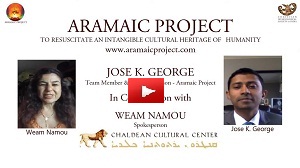
AP 340 to 321
ARAMAIC PROJECT - The Vision & Mission of Dr. JOSEPH J. PALACKAL, CMI
| Call Number | AP 338 |
| Part Number | Part I - Syro Malabar Church |
| Title | ARAMAIC PROJECT - the Vision & Mission of Dr. JOSEPH J. PALACKAL, CMI |
| Duration | 30m:02s |
| Place of Recording | Zoom Meeting |
| Date of Release | June 09, 2023 |
| Youtube URL | https://www.youtube.com/watch?v=uFIdhOnlY0M |
| Video Segment (s) |
|
Notes
JOSE K GEORGE member of Syro Malabar Church in conversation with Weam Noumi, spokesperson of Chaldean Cultural Center, USA on Aramaic Project.
Jose K George, a Team Member and Resource Contributor of the Aramaic Project narrates the importance of the project and contributions to the generations to come.
The Aramaic Project
The Vision & Mission of Dr. Joseph J. Palackal, CMI.
By Weam Namou : Chaldean Cultural Center.
The Aramaic language reached South India long before the Christian era. According to Rev. Dr. George Kurukkoor, a philologist and professor of Sanskrit and Malayalam languages, it arrived as far back as the 7th century BC when Sumerians, Babylonians, Jews, and others from the Middle East came to India in pursuit of commercial trade. In later centuries, its importance was replaced by other languages.
Like Iraqi Christians, the Christians in Kerala, India, trace the origin of their faith to St. Thomas the Apostle. Until the 1960s, they celebrated the liturgy in Aramaic but over time, the language and its songs began to face extinction in the Syro Malabar Church, which has 3.25 million members. This is one of the eight independent churches among the St. Thomas Christians (6 million out of about 30 million Christians in India) that follow the Chaldean (East Syriac) liturgical tradition.
This inspired Rev. Dr. Joseph J. Palackal, an Indic musicologist, singer, and composer, to initiate the Aramaic Project.
“The concept started after lifelong preparations,” said Palackal. In the 1970s when he was a seminarian, he heard a priest (Father Probus Perumalil, CMI) sing a song with unfamiliar melodies and instrumentals, and he was mesmerized by its uniqueness. “I didn’t know at that time that it was Aramaic and came from the Middle East with the influence of the Chaldean Church.”
In 1982, he wrote an article about the need to preserve this music’s heritage. He did his PhD dissertation on Aramaic chants in India. In 2006, he organized a recording of these songs by Rev. George Kurukkoor. He also worked on a commercial CD of Syriac chants; this has become a collector’s item because most of the singers have since died.
“The Aramaic language has undergone change in its pronunciation, vocabulary, and syntax in the Syro-Malabar Church in Kerala,” Palackal said. “All this treasure will be lost if we don’t document it and preserve it for future generations.”
The most challenging part of the project was locating Syriac (Aramaic) singers across Kerala. The word “Syriac,” of Greek origin, was associated with the region in Syria conquered by the Greeks. Jose George is a Chaldean from India who resides in Troy, Michigan. He explains that it was brought to India by the Portuguese in the 15th century.
The Portuguese, who colonized the country, viewed St. Thomas Christians as Nestorians and heretics and wanted them to speak Latin, Portuguese, or English. India thereafter adopted “Syriac” to refer to Aramaic, although they still use both words
“We don’t say Sureth because we don’t know that word; it’s used in Iraq,” said George. An engineer who provides IT services and consulting, he got involved in the Aramaic Project in 2016. He has since interviewed many people include Father Manuel Boji, Chaldean Catholic Christians from the Shlama Foundation, and most recently, Dr. Palackal.
A challenge for Dr. Palackal was convincing the hierarchy of his church about the significance of this project and the importance of the language. “I still haven’t achieved that goal,” he said, but it is his dream to do so because once they’re convinced, they could ask the government of India to contact UNISCO and ask them to declare the Aramaic language in India an endangered language and request for financial support to preserve it. “Then we can do much more,” he said. “We can make an impact on an international level.”
Palackal introduced two Aramaic chants to younger generations of Syro-Malabar Catholic Christians in America for the first time in 2013, at the National Basilica in Washington, DC, during the solemn celebration of Qurbana. There were 120 young singers from across America and they took to it—in fact, they were fascinated by it.
“Now this has become an essential component of Qurbana in Malayalam and in English among the young people in America,” he said. “I didn’t think this would happen in my lifetime, but I’m happy to see that.”
Recently, Palackal witnessed a Syro Malabar wedding in Queens where the young people sang in Aramaic. “That was a moment of great satisfaction,” he said. A very unexpected development was when a team from the Dharmaram, CMI study house seminary in Bangalore initiated an effort to compose new text in Aramaic. They wrote the poem and asked Palackal to compose it.
Keywords : #aramaicproject #josephpalackal #JoseKGeorge #ChaldeanCulturalCenter #aramaicpr oject#josephpalackal #JoseKGeorge
Related Videos
- AP 178 - Jose K. George on The Baptism of his children in The East Syriac Tradition.
- AP 208 - Exploring Elements from a Shared Liturgical Tradition. Fr. Manuel Boji in conversation with Jose K. George
- AP 209 - Rebuilding Bridges between Churches.The Chaldean Catholic Church of the East.Jose K. George Mappilaparampil
- AP 329 - VISION, MISSION, CHALLENGES, ADVANTAGES OF ARAMAIC PROJECT



